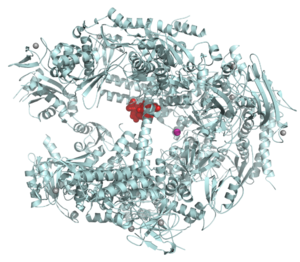
Back ناقلة (إنزيم) Arabic Трансферазы BE Трансфэразы BE-X-OLD Трансфераза Bulgarian Transferaza BS Transferasa Catalan Transferáza Czech Transferase Danish Transferase German Transferasa Spanish

In biochemistry, a transferase is any one of a class of enzymes that catalyse the transfer of specific functional groups (e.g. a methyl or glycosyl group) from one molecule (called the donor) to another (called the acceptor).[2] They are involved in hundreds of different biochemical pathways throughout biology, and are integral to some of life's most important processes.
Transferases are involved in myriad reactions in the cell. Three examples of these reactions are the activity of coenzyme A (CoA) transferase, which transfers thiol esters,[3] the action of N-acetyltransferase, which is part of the pathway that metabolizes tryptophan,[4] and the regulation of pyruvate dehydrogenase (PDH), which converts pyruvate to acetyl CoA.[5] Transferases are also utilized during translation. In this case, an amino acid chain is the functional group transferred by a peptidyl transferase. The transfer involves the removal of the growing amino acid chain from the tRNA molecule in the A-site of the ribosome and its subsequent addition to the amino acid attached to the tRNA in the P-site.[6]
Mechanistically, an enzyme that catalyzed the following reaction would be a transferase:
In the above reaction (where the dash represents a bond, not a minus sign), X would be the donor, and Y would be the acceptor.[7] R denotes the functional group transferred as a result of transferase activity. The donor is often a coenzyme.
- ^ "EC 2.7.7 Nucleotidyltransferases". Enzyme Nomenclature. Recommendations. Nomenclature Committee of the International Union of Biochemistry and Molecular Biology (NC-IUBMB). Retrieved 4 October 2020.
- ^ "Transferase". Genetics Home Reference. National Institute of Health. Retrieved 4 November 2013.
- ^ Moore SA, Jencks WP (Sep 1982). "Model reactions for CoA transferase involving thiol transfer. Anhydride formation from thiol esters and carboxylic acids". The Journal of Biological Chemistry. 257 (18): 10882–92. doi:10.1016/S0021-9258(18)33907-3. PMID 6955307.
- ^ Wishart D. "Tryptophan Metabolism". Small Molecule Pathway Database. Department of Computing Science and Biological Sciences, University of Alberta. Retrieved 4 November 2013.
- ^ Herbst EA, MacPherson RE, LeBlanc PJ, Roy BD, Jeoung NH, Harris RA, Peters SJ (Jan 2014). "Pyruvate dehydrogenase kinase-4 contributes to the recirculation of gluconeogenic precursors during postexercise glycogen recovery". American Journal of Physiology. Regulatory, Integrative and Comparative Physiology. 306 (2): R102–7. doi:10.1152/ajpregu.00150.2013. PMC 3921314. PMID 24305065.
- ^ Watson, James D. Molecular Biology of the Gene. Upper Saddle River, NJ: Pearson, 2013. Print.
- ^ Boyce S, Tipton KF (2005). "Enzyme Classification and Nomenclature". Encyclopedia of Life Sciences. doi:10.1038/npg.els.0003893. ISBN 978-0470016176.
![{\displaystyle {\ce {X-R + Y}}\quad {\xrightarrow[{\text{ transferase }}]{}}\quad {\ce {X + Y-R}}}](https://wikimedia.org/api/rest_v1/media/math/render/svg/f7cb2cab1d56dd82329258ba1af69425907bd6f7)